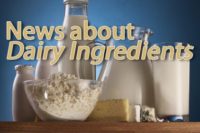Answers to Questions on Lowering Sugar in Beverages

To get the inside scoop on how to best do this, Dairy Foods interviewed Carolyn Merkel, executive director of ingredients, McNeil Nutritionals, Fort Washington, Pa. McNeil is the manufacturer and marketer of the low-calorie sweetener Splenda®.
DF: What is Splenda, and how is it made?
CM: Splenda is the brand name for sucralose. It is made from sugar through a patented, multi-step process that selectively replaces three hydrogen-oxygen groups on the sugar molecule with three chlorine atoms. The result is an exceptionally stable sweetener that tastes like sugar, but without sugar's calories. After consumption, sucralose passes through the body without being broken down for energy. That also makes it a no-calorie product.

CM: FDA approved sucralose in 1998 for use in 15 food and beverage categories, and later that year began appearing as a sweetener in popular products. The following year, FDA approved sucralose as a general-purpose sweetener. In 2000, Splenda was introduced in U.S. retail stores in both packets and granular form.
The FDA approval process for sucralose took about 11 years, which is typical for a food ingredient. To get a food ingredient approved, a company has to clearly demonstrate that the product can be safely consumed by all segments of the population, with no problems or issues. And we did just that, with no problem at all.
DF: How has it been doing since it was introduced?
CM: Outstanding! Since it was introduced in the retail market, consumers have made Splenda the No. 1 selling sweetener. It accounts for more than one-third of the market and has a lead of more than four share points on its nearest competitor, according to the latest scanner data (Information Resources Inc., April 20, 2003). Sucralose also is growing rapidly in the ingredient market. Since it was introduced five years ago as an ingredient in the United States it has been used in hundreds of products, with new products introduced every month. Worldwide, more than
3,000 food, beverage and nutritional products use sucralose as
an ingredient.

CM: Sucralose maintains its sweetness over time. The sweetness you taste when the product is made is maintained for the shelflife of the product. Sucralose also retains its great sugar taste at high temperatures. And sucralose blends exceptionally well with nutritive sweeteners, making blending a terrific option. Manufacturers can potentially lower their overall sweetener costs when blending with sucralose. From the standpoint of food and beverage manufacturers, those are significant advantages.
DF: That brings us to the purpose of this interview. Why blend sweeteners?
CM: Blending sweeteners provides two benefits. From a qualitative perspective, the finished product has a smoother, more rounded sweetness profile when more than one type of sweetener is used. This is true with nutritive and non-nutritive sweeteners, in most combinations. From a quantitative point-of-view, when you blend sweeteners, a sweetness synergy takes place. You actually need less to achieve the same or a better level of sweetness than any one single sweetener on its own.

CM: We have shown that this combination truly gives a manufacturer the most bangs for their buck. For example, when you blend two non-nutritive sweeteners, it's like one plus one equals three. When you blend sucralose with HFCS, it's like one plus one equals four.
Sucralose with HFCS can also be made to taste like HFCS alone, which appeals to consumers who want to lower their sugar intake, but do not like the taste of sugar-free beverages. Don't get me wrong. Many sugar-free beverages taste great, but there are a lot of consumers who do not like them. In fact, studies show that about 75% of the population does not like the taste of diet foods.
DF: We hear you have recent success stories in the fruit drink and dairy-based beverage categories. Please share the details.
CM: Wow, information spreads fast. Yes, sucralose was used to formulate the new Light Hawaiian Punch, which has 60% less sugar and 60% fewer calories than the original. Also, Swerve, which contains more than half milk, is sweetened through a blend of sucralose and HFCS. This keeps calories low, and nutrition high.
DF: Are diabetics a key user of sucralose?
CM: You bet, but it's not just diabetics who use sucralose, a broad range of consumers use it, including families. The fact that sucralose is made from sugar and therefore tastes like sugar-but without the calories-is an attribute that appeals to a broad range of customers.
DF: What is your relationship to the Atkins Diet? How important has that been to your success?
CM: The Atkins organization has been a terrific partner with our ingredient business. They use sucralose throughout their product line and sell packets of Splenda on their Website and through their catalogue. The Atkins Diet, as well as low-carbohydrate, high-protein dieting in general, is very popular and has definitely helped to introduce people to the benefits of sucralose.
Looking for a reprint of this article?
From high-res PDFs to custom plaques, order your copy today!



